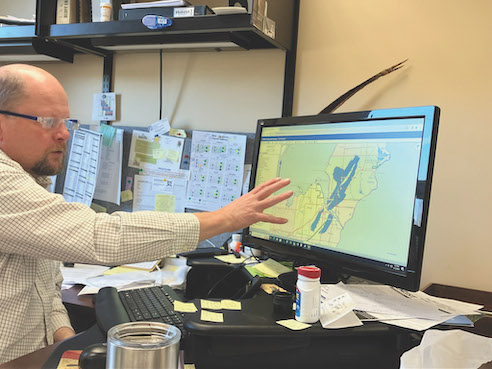County Digs Deep for Drinking-water Safety
- Share
- Tweet
- Pin
- Share

Groundwater.
It’s out of sight and probably out of mind for a good number of Door County’s residents and visitors.
A thin layer of soil covering fractured, quickly-draining rock makes most of the peninsula susceptible to groundwater contamination.
In a place like Door County, where residents and visitors rely upon 8,000 private wells for all their water needs – only the City of Sturgeon Bay, the Village of Sister Bay and the Town of Forestville in the Maplewood area have municipal water – groundwater isn’t out of mind for those whose jobs it is to keep it healthy for all of us for generations to come.
This means that county health and conservation officials not only enforce state rules but also have initiated state standards specifically for the county’s karst geology. In recent years, the county also launched two well-testing programs to find trouble spots and failing wells and keep people safe.
The county is in a good position to know what’s happening beneath the surface given its countywide, voluntary well test analysis from the University of Wisconsin-Oshkosh Environmental Research and Innovation Center (ERIC), in partnership with Door County Soil and Water Conservation Department and Door County Public Health.
This testing has been taking place for five years, enabling the county to build a database of water-quality data.
Those tests do not show widespread concern for well water safety countywide.
The tests track total coliform (bacteria), E. coli (fecal-related bacteria), nitrate and arsenic.
The total coliform, much of which is not harmful, showed up in 3% of 260 wells tested in spring 2022, but only 2% in fall 2023 and in less than 1% of 195 wells tested in spring 2023. Meanwhile, statewide, 17% of wells had excessive total coliform.

Traces of E. coli, which can make people sick, showed up in trace amounts in 1% of 162 wells tested in fall 2023 and at a slightly elevated amount in one well. But none have tested so far above 100 mpn (most probable number) per 100 milliliters – better than a state average of 5%.
“The biggest conclusion we have drawn is that the groundwater quality is extremely variable in Door County,” said Carmen Ebert, UW-Oshkosh ERIC lab manager. “If you observe any sudden changes in your well water quality such as odor, color, or turbidity [cloudiness], it is a sign that it could have contamination and should be tested.”
Nitrate Draws Attention in Specific Areas
At least in one location with a lot of small lots and homes with individual septic systems and holding tanks in Door County – along Bay Shore Drive and north of the bay of Sturgeon Bay – many household wells have repeatedly shown slightly elevated levels of nitrate, according to UW-Oshkosh test results.
The elevated levels may be partially due to shallow well depths, Ebert said.
“But we cannot say for certain without a thorough evaluation of several factors including well depth, well construction, land use, weather conditions, and other factors,” she said.
Nitrates might not make a person sick quickly, as certain bacteria do, but elevated levels of nitrates are dangerous for everyone (see related story in this issue).
To date, the data shows that among the wells tested in Door County, there is not a widespread problem with elevated nitrate-nitrogen levels. In those cases where testing does show elevated levels of nitrate, Coulthurst said the county wants to find causes.
“We want to dig deeper, so to speak,” Coulthurst said.
Over the first five years of testing through the county/UW-Oshkosh program, between 1% and 3% of wells tested above the safe-drinking-water standard for nitrate of 10 milligrams per liter in Door County. Statewide, 8% of private wells in Wisconsin exceed those nitrate standards, according to the Door County Soil and Water Private Well Monitoring program statistics.

Most of the wells with elevated levels of nitrate don’t have coliform bacteria or fecal-based E. coli bacteria, which more than likely would be present if septic tanks and mound systems were not working properly, Coulthurst said.
Nitrate can enter the ground and groundwater even after passing through a properly functioning septic system, however.
“Nitrates are not treated in a mound system,” Coulthurst said. “There are nitrates in our food matter, fecal matter, our urine. Once it gets into that nitrate or nitrite form, it won’t bond with the soils, which have a positive electric magnetism.”

In any case, if a resident is seeing sporadic or repeated tests showing high levels of nitrate, they should stop drinking that water or install either an under-sink treatment system or whole-house treatment system, he said. The county provides information on in-home treatment systems at co.door.wi.gov/531/Groundwater. The U.S. Environmental Protection Agency asserts that activated carbon filters, affixed to faucets or inserted into pitchers, “do not remove nitrates.”
Meanwhile, testing for arsenic in wells, over five years and seven rounds, has shown less than 1% of wells exceeding state health standards – compared to an average of 5%.
Arsenic naturally occurs in the soil, but not at levels high enough to exceed standards. Where health officials and conservationists are particularly vigilant about arsenic in Door County is near old orchard lands. Pesticides containing a mix of lead and arsenate powder were used widely between the late 1800s and at least the 1940s.
More Water Quality Testing
In addition to the UW-Oshkosh partnership, the county initiated more-targeted testing by awarding a contract to GZA GeoEnvironmental for a four-year well-testing program that uses professionals, rather than property owners, to collect the water samples. The company and county directly solicit participation by well owners, including farm owners, who did not get involved in UW-Oshkosh’s efforts to build a countywide database.
Sheryl Stephenson, project hydrogeologist with GZA GeoEnvironmental, said the first year of sampling was broad, with more focus on subsequent years on areas of identified concern. GZA chose areas where there has been no participation, or geologically-susceptible locations.
GZA reported its first results in December 2023, and they’re testing for E. coli and total coliform bacteria and nitrate and nitrite, just like UW-Oshkosh. But they also are testing for emerging contaminants and “forever chemicals” – such as per- and poly-fluorinated substances (PFAS), polycyclic aromatic hydrocarbons (PAHs), pesticides, personal-care substances, plastics and pharmaceuticals.
Eventually, she said, those tests will include phosphates.
The GZA testing results released in December 2023 showed no alarming issues with Door County well water in general. For PFAS, there were 10 detections out of 89 samples, with one of those exceeding safety standards. Arsenic showed up in 15 out of 89 samples, but only one exceeded standards. Only three of the 114 wells tested with nitrate levels unsafe for drinking, one of those on the eastern side of the peninsula in Sevastopol, the other two south of Sturgeon Bay.
E.Coli Contamination and Checking Success Around Ag Lands
Door and Kewaunee County officials in 2018 lobbied for new statewide Silurian Bedrock standards, to further protect groundwater in agricultural areas with fractured bedrock close to the surface.
“We showed them our well samples in Kewaunee and Door counties, saying we’ve implemented a lot of the farm practices, our groundwater is still being impacted, and we want additional practices on shallow soils,” Coulthurst said, recalling their 2017 and 2018 lobbying. “They came up with the Silurian standards for different practices. The biggest thing is no manure can be mechanically applied to soils less than 24 inches.
“In the past, the CAFOs, the big farmers, could not spread manure on less than 24 inches of soil over bedrock,” Coulthurst said. Meanwhile, operators of smaller farms, such as with 100 cows, still could spread liquid manure over fields with very little soil over bedrock. Not anymore with the new standards.
“Now it’s an even playing field across the board,” Coulthurst said.
In addition, the standards require pre-tillage of the soil before applications in late winter and early spring. Otherwise, earthworm holes and freeze-thaw cracks provide easy passage of liquids down to the rock.
Setback requirements and mapping guide where manure-spreading can and cannot take place.
“We’ll get calls occasionally saying ‘so and so is spreading,’ and is it legal?” he said. “We have audits. We go out in the field and bring the nutrient-management plan out there and see if they are putting on the correct rate and that they have the soil depths and the setback.”
This year, the county required well testing by several property owners near where manure- and slurry-spreading has taken place. Coulthurst believes progress is being made.
According to the Door County statistics, among tests analyzed by UW-Oshkosh, E. coli was not present in any, while 5% of wells statewide have some present, and total coliform was found at excessive levels in 1% to 3% of wells, compared to a state average of 17%. However, Coulthurst noted that new targeted well testing will focus on some agricultural areas that did not participate in the previous well-monitoring program.
“Part of what we’re trying to do is to see if what we’ve done on the landscape with the farmers is working, or has it worked,” said Coulthurst, who believes “to a large degree,” it has.
City Water
Municipal wells can become contaminated just as private wells can. To prevent or minimize those possibilities, municipal well operators are required to test regularly and report findings to the Department of Natural Resources as well as the public.
In addition, the city adopted a wellhead protection plan back in 2003 to manage potential contamination sources to aquifers used by municipal wells.
Water plant operators have to stay vigilant, and to that end, the county worked with Sturgeon Bay to create a wellhead protection program.
In 2003, the city worked with the county to set up a program to protect wells that draw water from aquifers that stretch several miles outside of the city’s jurisdiction, into the Town of Sturgeon Bay, southward into the Town of Nasewaupee and to the north into the Town of Sevastopol.
The city closed some of its shallowest wells. At the time that the wellhead protection plan took effect, three of the city’s five wells that were in service required ozone treatment to protect against bacteria.
Since then, the City of Sturgeon Bay has deeper wells – five that average between 305 and 477 feet deep – and they now have 300-foot-deep well casings to protect them from contamination from surface water, said Jeff Hoffman, Water and Wastewater utility manager.
A Rare and Fragile System
Door County Conservationist Greg Coulthurst strongly advises all Door County property owners to test their wells regularly given how quickly water travels through the shallow soils and fractured bedrock. A test one month might show contaminants that would be gone two months later and vice versa. Fall and spring tests have led a couple of property owners to replace failed septic systems.
For testing: The voluntary well-monitoring program through the county and the University of Wisconsin-Oshkosh takes place in the spring and fall. Registration for spring tests ended March 22. When signup reopens, a link will appear at tinyurl.com/3k7ns7me and in announcements from the county.
The county also provides information on where to get water testing kits and where to have them tested at co.door.wi.gov/569/Well-Water-Test-Kits.
Finally, GZA GeoEnvironmental welcomes people to sign up for free testing by professionals in the second year of a county-contracted, four-year program. Testing sites will be chosen based on criteria such as location, well depth and proximity source areas. If interested, visit gza.com/doorsignup or email [email protected].

